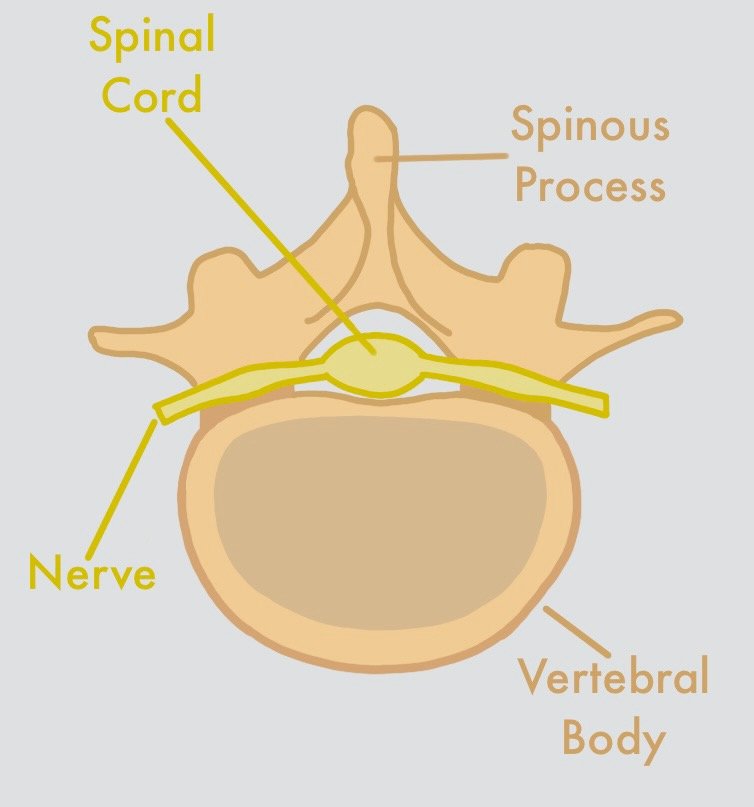Spinal Cord
Your spinal cord runs from the bottom of your head down to your tailbone. The spinal cord is like a highway, along which information travels from your brain to the rest of your body and vice versa. The brain and the spinal cord make up the central nervous system (CNS)
The spinal cord is made up of cells called neurons. At each level of the spine, the spinal cord gives off nerve roots, which contain neurons that communicate with each other and other cells in the body. These nerves connect the CNS with the peripheral nervous system (PNS), composing all the nerves outside of the brain and spinal cord.
Protecting the Spinal Cord
In addition to the spinal column, the spinal cord is also protected by the meninges, which contain cerebrospinal fluid. The meninges are a thin layer of tissue that wraps around the spinal cord, sort of like a ziploc bag. Within the ziploc bag is cerebrospinal fluid (CSF), which flows around the spinal cord. The CSF also protects the spinal cord, as well as provides nutrients and removes waste.
Spinal Cord Injury
Communication with the Body
Paraplegic: paralysis to the legs and lower body
If the injury occurs lower in the spinal cord, such as the thoracic or lumbar levels, a person may only have symptoms in their lower body. This can include difficulty moving and feeling the legs and feet.
Quadriplegic: paralysis to all four limbs
If the injury occurs high up in the spinal cord, such as the cervical level, a person may have symptoms in the arms, legs and chest. This can include difficulty moving and feeling the legs and arms, as well as an inability to hold their chest up.
The spine is organized into four major sections: cervical, thoracic, lumbar and sacral. These sections are further broken down into different levels. The cervical spine has seven levels, thoracic has 12, lumbar has five and sacral has five. At each level of the spine, the spinal cord gives off nerve roots, which travel to different tissues in the body.
The spina cord travels from the brain down to the tail bone within a hollow space called the spinal canal. Surrounding the spinal canal is bone, also known as the spinal column, which protect the spinal cord from injury.
Each nerve root is responsible for communicating with different parts of the body, depending on the level they originate from:
The cervical spinal cord begins at the base of the midbrain. The cervical nerve roots communicate with the upper body and are responsible for movement and sensation in the arms and hands.
The thoracic spinal cord and nerve communicate with the chest and upper back. These nerves innervate the rib cage, lungs, diaphragm and muscles that help you breathe as well as the abdominal cavity.
The lumbar spinal cord and nerves communicate with the low back and lower body. These nerves are responsible for movement and sensation in the legs. The spinal cord ends at the top of the lumbar spine, giving off nerve roots within the spinal canal, called the cauda equina.
The sacral nerves communicate with the tailbone, controlling urological function and well as bowel control.
MRI of the Cervical Spine
MRI of the Lumbar Spine
Sometimes, the spinal cord can become injured, which is known as a spinal cord injury. The symptoms that a person with a spinal cord injury experiences depend on where the spinal cord is injured.
There are several ways that a spinal cord injury can occur. However, the most common method of injury is trauma, such as a car crash. When trauma occurs, the structures around the spinal cord (bone and ligament) can be displaced or injured. This can cause the spinal cord to be put under a lot of pressure, which is what causes the spinal cord injury. When there is pressure on the spinal cord, neurons are injured and inflamed, which prohibits them from communicating information past the injury.
At each level, the spinal cord is responsible to sending information out to the body as well as to the rest of the spinal cord below it. If that communication is cut off due to injury, then no information can travel below that point in the spinal cord. This can result in people being unable to move or feel parts of their body, also known as paralysis.







